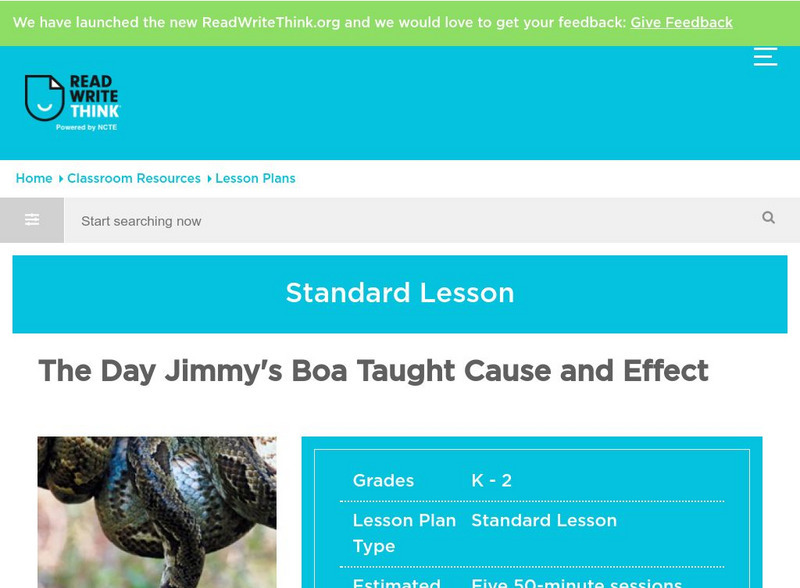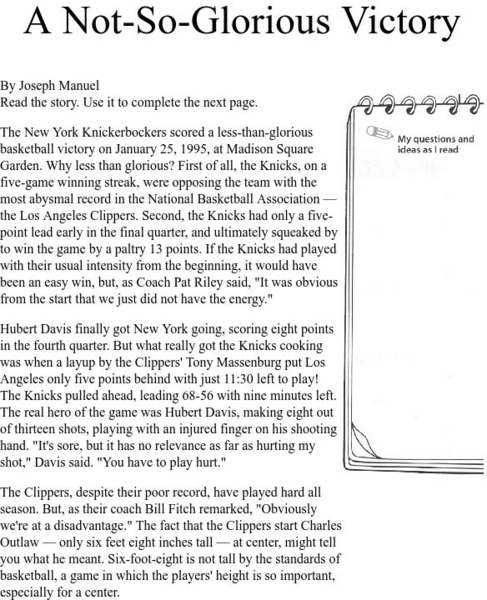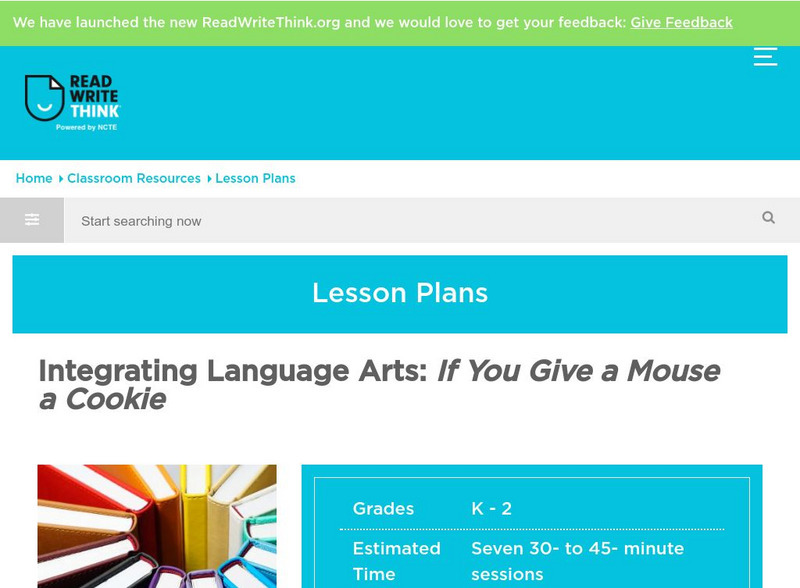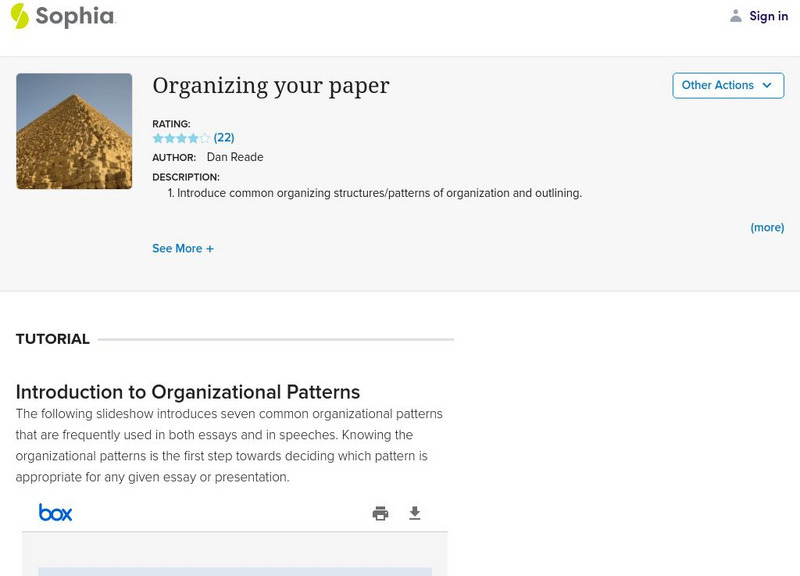Hi, what do you want to do?
EngageNY
TASC Transition Curriculum: Workshop 12
How can opinions slant facts? Workshop participants learn how to examine primary and secondary sources and identify the author's point of view. They also examine how visual art impacts the meaning and rhetoric of sources. Full of...
New York State Education Department
TASC Transition Curriculum: Workshop 4
Why is it important to use precise language? Participants explore this question in the fourth activity in a series of 15 on effective instruction. Perfect for all content areas, the activity promotes appropriate language choice through...
ReadWriteThink
Read Write Think: The Day Jimmy's Boa Taught Cause and Effect
Contains plans for five lessons that teach about cause and effect relationships using Trinka Hakes Noble's books about Jimmy and his boa constrictor. In addition to objectives and standards, this instructional plan contains links to...
Sophia Learning
Sophia: Cause and Effect Transition Words
This slideshow lesson focuses on cause and effect transition words; it defines and lists the categories of transition words. It discusses when to use cause and effect transition words, provides a list of sample words, and offers sentence...
Capital Community College Foundation
Guide to Grammar and Writing: Cause and Effect
Capital Community College gives excellent overview, assistance, and examples of using cause and effect in writing and composition.
Other
Style: Cause and Effect Writing
This site provides a list of what to do and not do for writing cause and effect essays. It also contains an evaluation checklist at the end which students can use for their own writing.
TES Global
Blendspace: Cause and Effect
This eleven-part Blendspace is designed to be used while teaching students how to analyze cause and effect. Links include reference sheets, a SMART Notebook Lesson, posters, practice worksheets, and guided practice opportunities.
Scholastic
Scholastic: Informational Text: Reading Response: Cause and Effect [Pdf]
This graphic organizer can be used as a reading response when working with informational text. Students will write two different effects and record multiple causes for each effect.
Scholastic
Scholastic: A Not So Glorious Victory
After reading "A Not-So-Glorious," Victory, which is included on this page, have your students practice identifying cause and effect using the printable worksheet.
ReadWriteThink
Read Write Think: Sequence of Events Chart
A printable graphic organizer to help students sequence events and recognize cause and effect relationships within a story. Directions on how to use this graphic organizer as well as lists of teaching ideas and related resources are also...
Polk Brothers Foundation Center for Urban Education at DePaul University
De Paul University: Center for Urban Education: I Can Analyze and Infer Causes & Effects [Pdf]
This graphic organizer will help students analyze and infer cause-effect relationships. Students will use the graphic organizer to guide them as they determine several causes for one effect. Then students will write to explain the...
ReadWriteThink
Read Write Think: Integrating Language Arts: If You Give a Mouse a Cookie
This lesson integrates reading, writing, listening, and speaking to boost students' comprehension skills. Students explore Laura Joffe Numeroff 's If You Give a Mouse a Cookie using a variety of techniques, beginning with a picture walk...
Scholastic
Scholastic: Investigating Nonfiction Part 3: Independent and Guided Reading
This article provides tips for using nonfiction with guided reading and independent reading. The following strategies are shared: ways to help kids select "just right" nonfiction books; lessons to use with nonfiction in guided reading...
PBS
Pbs Learning Media: Walmart Middle School Litercy Initiative
Interactive, student-paced lessons on such literacy skills as categorizing, comparing and contrasting, summarizing, evaluating, determining cause and effect, using text features, connecting, inferring, sequencing, understanding problems...
Sophia Learning
Sophia: Transition Words
Eight slides introducing different types of transition words including similarity, contrast, addition, illustration, and cause and effect words.
Education.com
Education.com: Draw the Story
[Free Registration/Login Required] Students will use their imagination to complete the story. How will it begin? How will it end? Great lesson for practicing sequencing.
Other
Kim's Korner: Patterns of Organization
Here is a run-down of several basic patterns of organization to use when writing. An example is given for each pattern, as well as an explanation.
Other
Prezi: Nonfiction Text Structures
Slideshow examines the five most common text structures used by authors to organize nonfiction writing.
Sophia Learning
Sophia: Organizing Your Paper
Two slideshows and a screencast on organizational patterns used when writing essays and speeches. The first is a 20-slide presentation explaining the seven most common organizational patterns used in writing: time sequence, spatial,...
Other
Allergy Glossary: Decongestant
This is a very brief write-up about decongestants, where you can read about how this medication can relieve congestion and how they can also cause adverse side effects.












![Scholastic: Informational Text: Reading Response: Cause and Effect [Pdf] Graphic Scholastic: Informational Text: Reading Response: Cause and Effect [Pdf] Graphic](https://content.lessonplanet.com/knovation/original/362057-df6bdead3be3f2e4ac48ce2bbdb8424d.jpg?1661510819)








